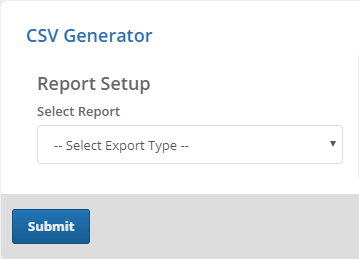
'Generates one sample of data ' # Select sample ID = self.list_IDs 'Denotes the total number of samples ' return len( self.list_IDs) 'Characterizes a dataset for PyTorch ' def _init_( self, list_IDs, labels): We make the latter inherit the properties of so that we can later leverage nice functionalities such as multiprocessing.Ĭlass Dataset( torch.

#CSV DATA GENERATOR HOW TO#
Now, let's go through the details of how to set the Python class Dataset, which will characterize the key features of the dataset you want to generate.įirst, let's write the initialization function of the class. Where data/ is assumed to be the folder containing your dataset.įinally, it is good to note that the code in this tutorial is aimed at being general and minimal, so that you can easily adapt it for your own dataset. In that case, the Python variables partition and labels look like > partitionĪlso, for the sake of modularity, we will write PyTorch code and customized classes in separate files, so that your folder looks like folder/

Let ID be the Python string that identifies a given sample of the dataset. Notationsīefore getting started, let's go through a few organizational tips that are particularly useful when dealing with large datasets. By the way, the following code is a good skeleton to use for your own project you can copy/paste the following pieces of code and fill the blanks accordingly.
#CSV DATA GENERATOR GENERATOR#
In order to do so, let's dive into a step by step recipe that builds a parallelizable data generator suited for this situation. This article is about optimizing the entire data generation process, so that it does not become a bottleneck in the training procedure. # Train model for epoch in range(max_epochs):įor local_X, local_y in training_generator: Training_generator = SomeSingleCoreGenerator( 'some_training_set_with_labels.pt ') Tutorial Previous situationīefore reading this article, your PyTorch script probably looked like this:
#CSV DATA GENERATOR FULL#
This tutorial will show you how to do so on the GPU-friendly framework PyTorch, where an efficient data generation scheme is crucial to leverage the full potential of your GPU during the training process.

In this blog post, we are going to show you how to generate your data on multiple cores in real time and feed it right away to your deep learning model. That is the reason why we need to find other ways to do that task efficiently. We have to keep in mind that in some cases, even the most state-of-the-art configuration won't have enough memory space to process the data the way we used to do it. Have you ever had to load a dataset that was so memory consuming that you wished a magic trick could seamlessly take care of that? Large datasets are increasingly becoming part of our lives, as we are able to harness an ever-growing quantity of data. Fork Star pytorch data loader large dataset parallelīy Afshine Amidi and Shervine Amidi Motivation


 0 kommentar(er)
0 kommentar(er)
